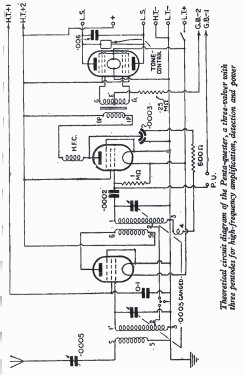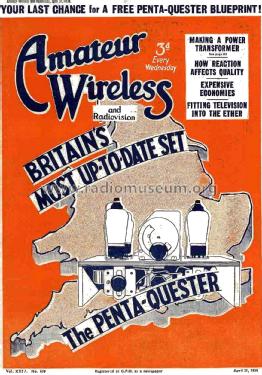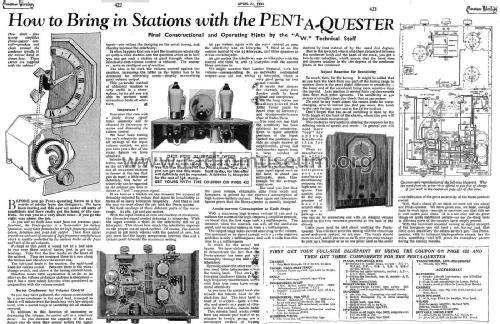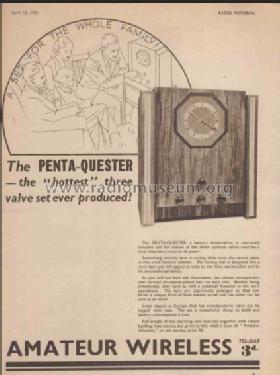- País
- Gran Bretaña (GB)
- Fabricante / Marca
- Amateur Wireless and Electrics & Amateur Wireless and RadioVision Magazines; London
- Año
- 1934
- Categoría
- Kit (Partes con instruciones) o Solo Instrucciones
- Radiomuseum.org ID
- 354747
Haga clic en la miniatura esquemática para solicitarlo como documento gratuito.
- Numero de valvulas
- 3
- Principio principal
- RFS con reacción (regenerativo)
- Gama de ondas
- OM y OL
- Tensión de funcionamiento
- Pilas + jack (etc.) para alimentación externa. / 2, 9, 120 Volt
- Altavoz
- Altavoz dinámico (de imán permanente)
- Material
- Madera
- de Radiomuseum.org
- Modelo: Penta-Quester - Amateur Wireless and Electrics
- Forma
- Sobremesa alto de forma simple.
- Anotaciones
-
The 1934 Penta-Quester radio, announced in April 1934, was a high-tech marvel for hobbyists. It used pentode valves for superior performance and boasted a unique clock-face tuning dial for easy station selection.
Technical Summary of the 1934 Penta-Quester Radio:
Circuit:
- Battery-operated, 3-valve superheterodyne design
- Uses pentode valves for high-frequency amplification, detection, and class-B output (novel for the time)
- Two tuned circuits with a high-frequency transformer
Tuning:
- Dual-gang condenser for band selection
- Clock-face tuning dial with independent condenser control
- Local aerial system with metal bars integrated into the cabinet
- Other Features:
- Table style cabinet with self-contained batteries
- Moving-coil loudspeaker
- Wood chassis with metal baseboard and sub-chassis wiring
- Double tone control (one fixed, one variable)
- Input volume control via variable aerial condenser
- Differential reaction condenser for smooth control
- Pick-up terminals for connecting an external source (e.g., record player)
Overall:
The Penta-Quester was a technically advanced radio for its time, offering high performance and innovative features like the clock-face tuning dial and local aerial system.
It was a popular design among amateur radio enthusiasts due to its use of pentode valves and its ability to receive stations with strong signal strength and good selectivity.
- Mencionado en
- -- Original prospect or advert (Amateur Wireless Apr 7, 1934, Page 363)
- Autor
- Modelo creado por Gary Cowans. Ver en "Modificar Ficha" los participantes posteriores.
- Otros modelos
-
Donde encontrará 2 modelos, 2 con imágenes y 2 con esquemas.
Ir al listado general de Amateur Wireless and Electrics & Amateur Wireless and RadioVision Magazines; London




